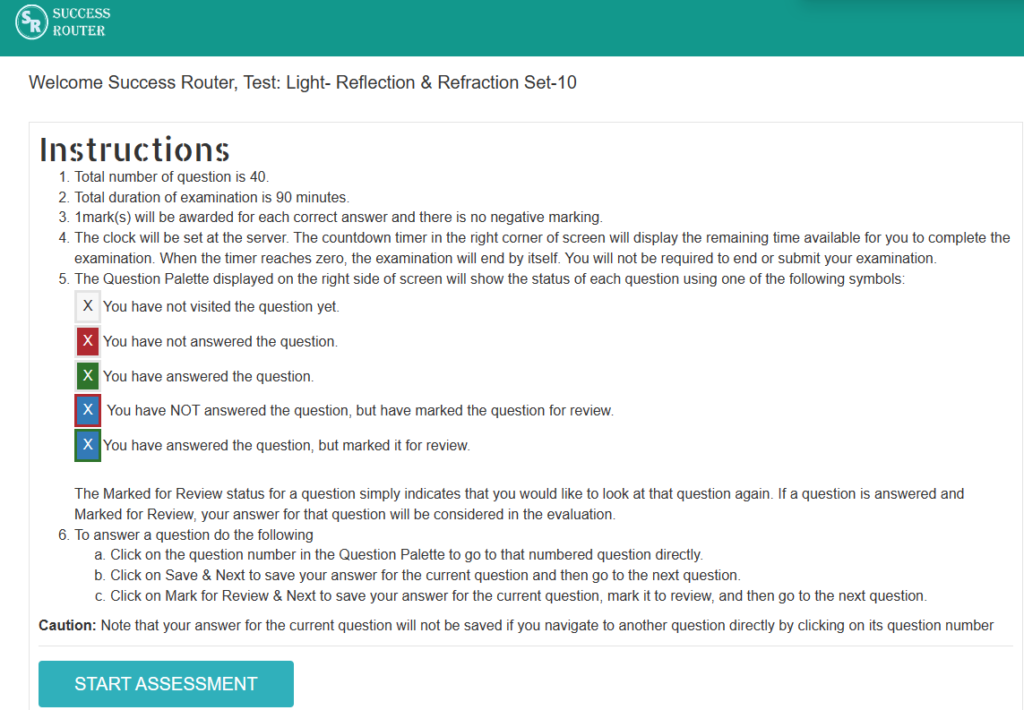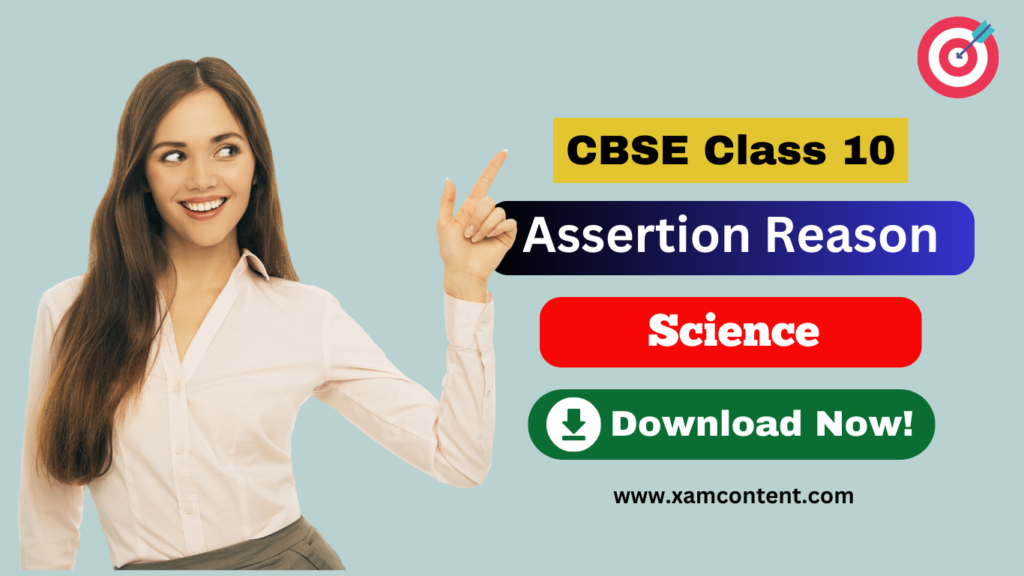Last Updated on August 26, 2024 by XAM CONTENT
Hello students, we are providing assertion and reason questions for class 10 science. Assertion reason questions are the new question format that is introduced in CBSE board. The resources for assertion reason questions are very less. So, to help students we have created chapterwise assertion reason questions for class 10 science. In this article, you will find assertion reason questions for CBSE Class 10 Science Chapter 10 Light – Reflection and Refraction.
| Chapter | Light – Reflection and Refraction |
| Type of Questions | Assertion Reason Questions |
| Nature of Questions | Competency Based Questions |
| Board | CBSE |
| Class | 10 |
| Subject | Science |
| Useful for | Class 10 Studying Students |
| Answers provided | Yes |
| Difficulty level | Mentioned |
| Important Link | Class 10 Science Chapterwise Assertion Reason |
Assertion Reason Questions on Light – Reflection and Refraction
Directions:
(a) Both A and R are true and R is correct explanation of the assertion.
(b) Both A and R are true but R is not the correct explanation of the assertion.
(c) A is true but R is false.
(d) A is false but R is true.
Q 1. Assertion: If a ray of light is incident on a convex mirror along its principal axis, then the angle of incidence as well as the angle of reflection for a ray of light will be zero.
Reason: A ray of light going towards the centre of curvature of a convex mirror is reflected back along the same path.
Difficulty Level: Medium
Ans. (b)
Q 2. Assertion: Linear magnification of a mirror has no unit.
Reason: The ratio of height of the image to the height of the object is the linear magnification produced by mirror.
Difficulty Level: Medium
Ans. (a): Linear magnification of a mirror is the ratio of height of the image (cm) and the height of the object (cm) and it has no unit.
Also read: Numerical Problems on Convex and Concave Mirror with Answers
Q 3. Assertion: In the case of concave mirror, the minimum distance between real object and its real image is zero.
Reason: If concave mirror forms virtual image of real object, the image is magnified.
Difficulty Level: Medium
Ans. (b): If object is placed at centre of curvature of concave mirror, its image is at the centre of curvature. Thus, minimum distance between object and its real image is zero. If object is between pole and focus of concave mirror, its image is virtual and magnified.
Q 4. Assertion: The size of the mirror affects the nature of the image.
Reason: Small mirrors always form virtual images.
Difficulty Level: Easy
Ans. (d): The size of the image does not affect the nature of the image except that a bigger image as it gathers more light rays due to wider aperture.
Q 5. Assertion: Keeping a point object fixed, if a plane mirror is moved, the image will also move.
Reason: In case of a plane mirror, distance of object and its image is equal from any point on the mirror.
Difficulty Level: Medium
Ans. (a): The image formed in a plane mirror is at the same distance behind the mirror as the object is in the front of the mirror. Image and the object are at equal distances from a plane mirror.
Also check
- Chemical Reactions and Equations Class 10 Assertion Reason Questions Science Chapter 1
- Human Eye and Colourful World Class 10 Assertion Reason Questions Science Chapter 10
- Life Processes Class 10 Assertion Reason Questions Science Chapter 6
- Light – Reflection and Refraction Class 10 Assertion Reason Questions Science Chapter 10
You may also like
Topics from which assertion reason questions may be asked
- Introduction to Light
- Reflection Of Light
- Spherical Mirrors
- Image Formation and Uses of Spherical Mirrors
- Mirror Formula and Magnification
- Refraction of light
- Formation of Image by different Lenses
- Lens Formula, Magnification and Power of Lens
You are going to study the above topics in class 10 light chapter. So, assertion reason questions based on above topics may be asked.
We hope the given Assertion and Reason Questions for Light – Reflection and Refraction Class 10 Science helps you in your learning.
Helpful Links for CBSE Class 10 Science Preparation
- Download 125 Important Case Study Questions for CBSE Class 10 Science
- Download 220 Important Assertion Reason Questions for CBSE Class 10 Science
- Download 225 Practical Based Questions for CBSE Class 10 Science
- Download 65 Important Numerical Problems for CBSE Class 10 Physics
- Download 60 Important Diagram Based Questions for CBSE Class 10 Physics
- Download 150 Most Repeated Questions for CBSE Class 10 Science
- Download Chapter Test for CBSE Class 10 Science
Quiz
| Topic | Light – Reflection and Refraction of Light |
| Useful for | CBSE Class 10 Students |
| Type of Questions | MCQs |
| No. of Questions | 40 |
| Solutions | Instant Solutions after Completion of Quiz |
| Quiz Link | Click here to Take Test |
| Price | Free |
How to take quiz or test using the given link
It’s quite simple!
Step 1: Click on the given link. You will see the below screen.

Step 2: Fill in the necessary details. There is no need to register. Just fill your email and name and click on the button “Take Assessment”. The below screen will appear.

Step 3: Click on start assessment. Now you are ready to take test.

Frequently Asked Questions (FAQs) on Light – Reflection and Refraction Assertion Reason
Q1: What are Assertion Reason questions in CBSE Class 10 Light?
A1: Assertion Reason questions are a type of question format where students are provided with a statement (assertion) followed by a reason for that assertion. They are required to evaluate whether the assertion and the reason are true and whether the reason explains the assertion.
Q2: How are Assertion Reason questions different from other question types?
A2: Assertion Reason questions require students to think critically and analytically. Unlike direct questions that test recall or understanding, Assertion Reason questions assess students’ ability to apply concepts, analyze information, and make logical connections.
Q3: Why are Assertion Reason questions important in the CBSE Class 10 Light curriculum?
A3: Assertion Reason questions help students develop higher-order thinking skills such as reasoning, inference, and deduction. They encourage students to understand the underlying principles behind concepts rather than just memorizing facts.
Q4: Where can I find more assertion-reason questions on Light – Reflection and Refraction for practice?
A4: We offer a collection of assertion-reason questions for all classes and subject on our website. These questions are designed to help students practice critical thinking skills and reinforce their understanding of scientific concepts. Visit our website to access these questions and enhance your learning experience. If you need more assertion reason for CBSE then you can visit Physics Gurukul website. They have a large collection of assertion reason questions for every classes.
Q5: Is light a form of energy?
A5: Yes, light is a form of energy.
Q6: What is value of speed of light in vacuum?
A6: The speed of light in vacuum is 3 x 106 m/s
Q7: Do the laws of reflection hold good for spherical mirrors?
A7: Yes, laws of reflection hold good for spherical mirrors.
Q8: If the radius of curvature of a concave mirror is 40 cm, what is its focal length?
A8: f = R/2 = 40/2 = 20 cm
Q9: One reads a newspaper due to the light reflected from it. Why then we do not see even faint image of ourselves in the newspaper?
A9: The newspaper causes scattering of light, which is an irregular and diffused sort of reflection. From each point, light goes in all directions. The image is seen only when there is regular refection of light. It is the homogeneous nature of the surface which causes irregular reflection or scattering of light.
Q10: State the laws of reflection.
A10: There are two laws of reflection: (1) The first law states that the angle of incidence is equal to the angle of reflection.
(2) The second law states that the incident ray, the reflected ray and the normal to the point of incidence at the reflecting surface, all lie in the same plane
Q11: How should students approach Assertion Reason questions in CBSE Class 10 Light?
A11: Students should carefully read both the assertion and the reason provided. They should evaluate whether both statements are individually true and whether the reason logically explains the assertion. If both statements are true and the reason correctly explains the assertion, they should select the appropriate option.


